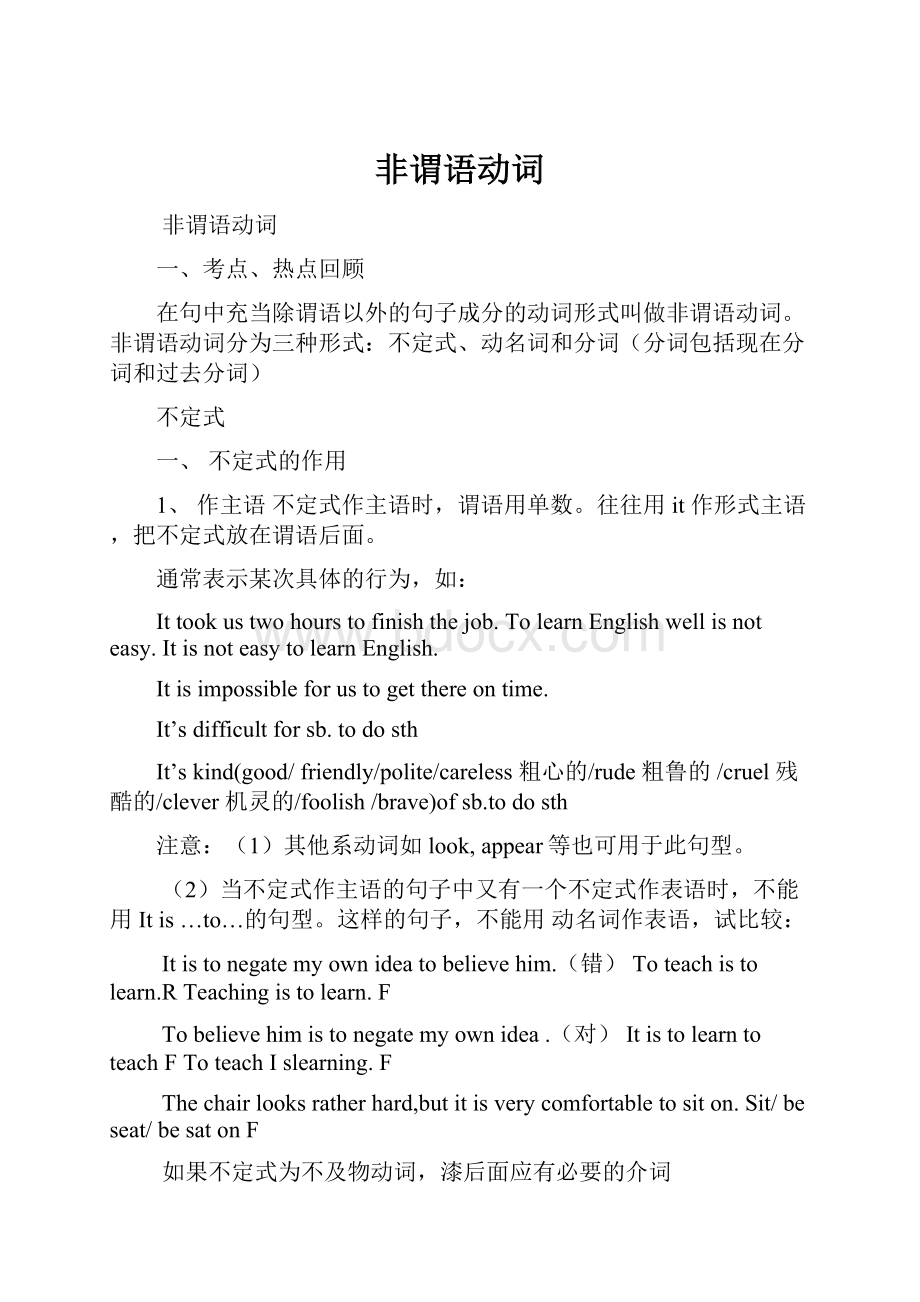非谓语动词.docx
《非谓语动词.docx》由会员分享,可在线阅读,更多相关《非谓语动词.docx(33页珍藏版)》请在冰豆网上搜索。

非谓语动词
非谓语动词
一、考点、热点回顾
在句中充当除谓语以外的句子成分的动词形式叫做非谓语动词。
非谓语动词分为三种形式:
不定式、动名词和分词(分词包括现在分词和过去分词)
不定式
一、不定式的作用
1、作主语不定式作主语时,谓语用单数。
往往用it作形式主语,把不定式放在谓语后面。
通常表示某次具体的行为,如:
Ittookustwohourstofinishthejob.TolearnEnglishwellisnoteasy.ItisnoteasytolearnEnglish.
Itisimpossibleforustogetthereontime.
It’sdifficultforsb.todosth
It’skind(good/friendly/polite/careless粗心的/rude粗鲁的/cruel残酷的/clever机灵的/foolish/brave)ofsb.todosth
注意:
(1)其他系动词如look,appear等也可用于此句型。
(2)当不定式作主语的句子中又有一个不定式作表语时,不能用Itis…to…的句型。
这样的句子,不能用动名词作表语,试比较:
Itistonegatemyownideatobelievehim.(错)Toteachistolearn.RTeachingistolearn.F
Tobelievehimistonegatemyownidea.(对)ItistolearntoteachFToteachIslearning.F
Thechairlooksratherhard,butitisverycomfortabletositon.Sit/beseat/besatonF
如果不定式为不及物动词,漆后面应有必要的介词
(3)Itis+adj.of/forsb.todosth.结构中,当不定式的逻辑主语和前面的形容词可以构成系表结构时,用of,否则用for.
1)forsb.用于easy,hard,difficult,interesting,impossible表示客观形式的形容词
It’sveryhardforhimtostudytwolanguages.
2)ofsb.good,kind,nice,clever,foolish,right.表示主观形式的形容词
It’sverykindofyoutohelpme.
2、作宾语
(1)动词+不定式。
如:
注:
下列动词通常用不定式作宾语:
want,try,hope,wish,need,forget,know,promise,refuse,help,decide,begin,start,learn,agree,choose,get,afford提供,给予,aim打算,arrange,ask,bother,care,choose,demand要求,需要,desire渴望,期望,determine决定,确定,
Elect选择,选举,endeavor尽力,hope,fail,long渴望,happen,mean,manage,offer,plan,pretend,refuse,tend照管,护理,undertake承担,担任,expect,hate,intend想要,打算,prepare,order,cause引起,促成,beg,agree.等
Hemanagedtoescapefromthefire.
Ifindithardtogetalongwithhim.(it作形式宾语)
Thedriverfailedtoseetheothercarintime.司机没能及时看见另一辆车
Heofferedtohelpme.他表示愿意帮助我
Ilikeyoutokeepeverythingtidy./Iliketokeepeverythingtidy.
(2)动词+疑问词+to,“特殊疑问句+不定式”相当于名词,作宾语。
如:
Decide,know,consider,forget,learn.remember,show,wonder,findout,tell,inquire,explain等
Idon’tknowwhattodonext/howtodoitnext.
Ican’tdecidewhentogothere.
Plsshowushowtodothat.
Therearesomanykindsoftape-recordersonsalethatIcan’tmakeupmindwhichtobuy.
注意:
不定式短语作宾语时,如果还带有宾语补足语,往往把不定式短语放在宾语补足语之后,用it作形式宾语。
如:
Ifinditnecessarytolearnaforeignlanguage.
3、作宾语补足语
(1)动词+宾语+不定式(todo)。
如:
Hewarnedmetobecareful.
IwantyoutospeaktoTom.
Whatmakesyouthinkso?
(不带to的不定式)
注:
可以用动词不定式做宾补的动词有
主语+ask/want/tell/get/force/expect/advise/invite/order/allow/require/like/
wouldlike/help/wish/warn/prefer/encourage/prefer/beg/hate/persuade/
cause/waitfor/callon/permit/forbid+sb.todosth.
主语+cause/challenge/command/compel/drive驱使/enable/forbid/impel/induce
/instruct/make/let/have/persuade/request/send/train/urge+sb.todosth.
Thedoctoradvisedhimtostayinbedforanotherfewdays.
Wewishhimtoremainandacceptthepost.留下来接收这个职位
Fatherwillnotallowustoplayonthestreet.
Theofficerorderedhismentofire.(开火)
Consider用动词be以外的不定式做宾补时,一般要求用不定式的完成式。
Heisgenerallyconsideredtohaveinventedthefirstcomputer.
(2)表见解、看法的动词结构可为:
动词+宾语+tobe的不定式结构。
如:
主语+think/judge/suppose/believe/consider/imagine/feel/find/declare声称
Appoint/guess/fancy设想/guess/judge/know+sb.+tobe/tohavedone
WeconsiderTomtobeoneofthebeststudentsinourclass.
Thebookisbelievedtobeuseful.(被动语态)
Weknowhimtobeafool.笨蛋
Webelievehimtobeguilty.有罪的
主语+callon/upon/dependon/waitfor/askfor+sb.+todosth.
(3)There+tobe如:
Believe/expect/intend/like/love/mean/prefer/want/wish/understand+theretobe
Wedidn’texpecttheretobesomanypeoplethere.我们没料到会有那么多人在那里。
Youwouldn’twantwanttheretobeanotherwar.你不至于想让另一场战争发生吧
注意:
(1)有些动词需用as短语作补语,像regard,think,believe,take,consider。
如:
WeregardTomasourbestteacher.我们认为汤姆是我们最好的老师。
Marytookhimasherfather.玛丽把他当作自己的父亲。
(2)在动词feel(一感),hear,listento(二听),have,let,make(三让),notice,see,watch,observe,lookat(五看)(即:
吾看三室两厅一感觉)等后面的补足语中,不定式不带to,但变为被动语态后,必须带to。
如:
Theysawtheboyfalloffthetree.Theboywasseentofalloffthetree.
Wenoticedhimenterthehouse.留意到Thebossmadethemworktwelvehoursaday.让他们
注意当make、have不做“迫使、让”讲,而做“制造、有”解时,跟带有to的不定式做状语。
Mothermadeacaketocelebratehisbirthday.妈妈做了一个蛋糕给他庆贺生日。
Hehadameetingtoattend.他有个会要开。
下列动词后的复合宾语用分词做宾补:
see,watch,notice,observe,hear,feel,make,set,have,leave,keep,find等。
用现在分词还是用过去分词做宾补,要看分词与宾语的关系。
例
Weheardhimsingingthesongwhenwecamein.当我们进来的时候,听见他正唱那首歌
Wehaveheardthesongsungtwice.我们听过这首歌唱过两遍了。
(3)help后面作宾语补足语的不定式可以带to,也可以不带to.
Ioftenhelphim(to)cleantheroom.
Ihelpedhim(to)findhisthings.
3)用作介词的to
Admitto,objectto,beaccustomedto,beusedto,stickto,turnto,lookforwardto,bedevotedto,
payattentionto,contributeto,apologizeto,devoteoneselfto等
4、作定语
不定式作定语,修饰名词或代词,放在修饰的名词后,表示谓语动词之后发生的动作或过去的某一特定动作;不定式和它所修饰的名词之间有逻辑上的主谓关系、动状关系、同位关系或动宾关系。
不定式通常要放在这些被修饰的词后。
如:
Ihavealotofworktodo.(动宾关系)Heislookingforaroomtolivein.(动状关系)
Heisthefirstpersontothinkoftheidea.(主谓关系)
Hehasgotachancetogoabroad.(同位关系)
Hehadnohousetolivebutalotofworktodo.
Ourmonitoristhefirsttoarrive.我们班长是第一个到的
注意:
1.不定式的逻辑主语是句子的主语时,不定式用主动形式表被动。
如:
Doyouhaveanythingelsetosay?
2.如果作定语的不定式是一个短语,则要保留不定式短语中的副词或介词。
如:
Ineedapentowritewith.(Iwillwirtewiththepen)(我需要一支钢笔写字)
Ihavealittlebabytolookafter.(Imustlookafterthelittlebaby)(我有一个婴儿要照看)
5.作状语,表示目的、结果、原因等,有时还有一些固定搭配的不定式短语,如
(1)做目的状语,
inorderto,为了,以便,为的是,目的在于(目的状语)
soasto,so(such)….astodo以便,为的是(如此···以便···)(结果状语)
enoughto
Thegirlwassokindastohelptheoldmanoffthebus.
Heransofastastocatchthefirstbus.他飞快地跑以便赶上第一班车。
Thetestquestionsarekeptsecret,soastopreventcheating.以防作弊
I‘mnotsuchafoolastobelievethat.
Tomkeptquietabouttheaccidentsoasnottolosehisjob.汤姆对事故保持沉默是为了不丢掉工作
Goinquietsoasnottowakethebaby.轻点进去……
Tomakehimselfheard,heraisedhisvoice.为了被听清楚,他提高了嗓门
(2)作结果状语,表事先没有预料到的,要放在句子后面。
如:
Onlytodo(…….,结果却….表示于句子谓语动作的目的相反的结果)
Onlytofind。
。
。
结果发现。
。
。
。
,最后发现
Hehurriedtothepostofficeonlytofinditwasclosed.
Wehurriedtotheclassroomonlytofindnonethere.
Hesearchedtheroomonlytofindnothing.
Iawoketofindmytruckgone.醒来发现箱子不见另了
(3)做原因状语。
to如:
Wewereveryexcitedtohearthenews.
Hecametotheschooltoseehisson.
I’mgladtoseeyou.
Allofusaresurprisedtoseehisrapidprogress.我门都很吃惊。
。
。
。
(4)做条件状语。
如:
Toturntotheleft,youcouldfindapostoffice.
(5)不定式完成式的特殊用法:
a.表示不定式中谓语动词发生的动作先于主语的谓语动词发出的动作
Seem/appear/besaid/besupposed/bebelieved/bethought/beknow/bereported
Thenovelwassaidtohavebeenpublished.
Iregrettohavebeenwithyouforsomanyyears.
Iwassorrytohavekeptyouwaiting.(说话时已等了很久)
b.“表示过去本想做某事但未做”的虚拟语气
Shouldliketo/wouldliketo/wouldloveto+不定式的完成式
c.表示该做某事或想做但未实现Was/wereto+不定式的完成式
d.表示过去未曾实现的愿望
Expect/hope/mean/promise/suppose/think/want/wish+不定式的完成式
6.作表语
不定式可放在be动词后面,构成表语。
不定式做表语常表示谓语动词所表示动作之后发生的动作。
如:
Thequestionishowtoputitintopractice.
Myquestioniswhentoleave.Hisdreamistobeadoctor.Herworkistolookafterthebabies.
Histeachingaimofthisclassistotrainthestudents’speakingability.
注意:
1.不定式在句中作表语时,对应的谓语动词用单数。
2.当主语是不定式时,表语不能用Ving形式,可用不定式。
如:
Toseeistobelieve.(眼见为实)
7.独立结构。
如:
Totellyouthetruth,Idon’tagreewithyou.
Tomakemattersworse,itbegantorain.
二、不定式的时态和语态
1、不定式的时态
(1)现在时:
有时与谓语动词表示的动作同时发生,有时发生在谓语动词的动作之后。
如:
Heseemstoknowthis.Ihopetoseeyouagain.
(2)完成时:
表示的动作发生在谓语动词表示的动作之前。
如:
I’msorrytohavegivenyousomuchtrouble.
Heseemstohavecaughtacold.Heseemedtohavecleanedtheroom.
(3)进行时:
表示动作正在进行,与谓语动词表示的动作同时发生。
如:
Heseemstobeeatingsomething.Heseemtobereadingsthatthattime.
(4)完成进行时:
表示动作从过去某个时间开始,一直延续到现在,并有可能持续下去。
如:
Sheisknowntohavebeenworkingontheproblemformanyyears.
2、不定式的语态
当不定式的逻辑主语是其动作的承受者时,就用被动式。
如:
Hewasseentoenterthehall.
HeaskedtobesenttoworkinTibet.
Theworkistobedonesoon.
TheboyissaidtohavebeensenttohospitalYesterday.
三、省to的动词不定式
1、情态动词(除ought外,oughtto)
2、Wouldrather,hadbetter.
3、感官动词see,watch,lookat,notice,observe,hear,listento,smell,feel等后作宾补,省略to.
注意:
在被动语态中to不能省略掉。
如:
Isawhimdance.Hewasseentodance.Thebossmadethemworkthewholenight.
Theyweremadetoworkthewholenight.
4、使役动词let,have,make.
5、由and,or和than连接的两个不定式,第二个to可以省去。
如:
HewantstomovetoFranceandmarrythegirl.
6、Help可带to,也可不带to,helpsb.(to)dosth.
7、Why…/Whynot…Whynottakeaholiday?
8、But和except前是动词do时,后面出现的动词用不带to的动词不定式。
试比较:
Hewantstodonothingbutgoout.
Hewantstobelieveanythingbuttotakethemedicine.
动名词(动名词具有动词和名词的特征,在句中作主语、表语、宾语和定语)
一、动名词的作用
1、作主语,往往表示普通、一般的行为,动名词做表语是对主语内容的解释,主语与表语位置可以呼唤,动名词常用于口语,谓语用单数。
It代替动名词作主语,常用于如下结构:
It’snogood/use/fundoing···It’sworthwhiledoing.如:
Itsfull-timeislayingeggs.It’snogoodwaitinghere.
Playingwithfireisdangerous.Seeingisbelieving.
Collectinginformationaboutchildren’shealthishisjob.
2、作宾语
Ienjoylisteningtomusic.
Heoftenpracticesplayingthepianointheevening.
Heisfondofplayingbasketball.
Hehasgivenupsmoking.
Wouldyoumindturningdownyourradioalittle,please?
(1)只能接动名词作宾语的动词:
admit,advise建议,risk,appreciate,envy嫉妒,avoid避免,
consider考虑,delay延迟,deny否认,dislike不喜欢,enjoy,escape逃避,excuse原谅、宽恕,
finish完成,forgive原谅,understand理解,giveup放弃,imagine想象,keep保持,mind介意、在乎,
mis